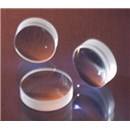What are achromatic lenses (doublets)?
Chromatic aberration is caused by the difference of dispersion and refractive index of light at different wavelengths in glass, which results in different focal points of light at different wavelengths. The dispersion of each glass can be compensated by another glass by using different materials, such as crown and flint glass in convergent and divergent lenses, so that the comprehensive chromatic aberration can be minimized. The crescent surface of the lens (Meniscus Lens) can further limit spherical aberration and comet aberration.
Therefore, achromatic lenses are made of convex and concave lenses made of two kinds of glass with different optical properties. Convex lenses are usually made of coronal glass with small refractive index and larger dispersion, and concave lenses are made of flint glass with larger refractive index and smaller dispersion.
Two-piece achromatic lenses(doublets) are the simplest structure of achromatic lenses. It can be divided into two types: gluing and separating. Of course, achromatic lenses can also be composed of multi-lenses, depending on its application.
Achromatic lenses are widely used. A multi-lens optical system usually consists of several achromatic lenses. High-quality microscopes and photographic apparatus are complex lens systems which can eliminate both hyperchromatic and other monochromic aberrations.
In addition to spherical type, you may also find cylindrical achromatic doublets here.
Achromatic Lenses Size
Achromatic lenses are normally made of optical glass, fused silica and CaF2.
Special focusing systems can be designed by Photonchina’s engineer team.
Normal Achromatic Lens
| LENSES | MATERIALS | ILLUSTRATION | PROPERTIES AND APPLICATIONS |
| ACHROMATIC LENS | Combinations of Two Optical Grade Glasses | These lenses have considerably reduced values of spherical aberrations. Best used to replace single components where performance must be improved. |
Super Small Achromatic Lens
Super small Achromatic Lenses for your specific application provide excellent wavefront quality, super small spot size and improved modulation transfer function (MTF).
Feature
- Small diameter size up to 3mm
- Short focal length, such as 5mm
- Strict quality control, excellent quality
- AR-coating, mounts services
Specifications
| DIAMETER SIZE | smallest 3 mm |
| DIAMETER TOLERANCE | +0.0, -0.05mm |
| PARALLEL FOCAL LENGTH TOLERANCE | ±2% |
| CENTRATION | 5 arc minutes |
| CLEAR APERTURE | >80% |
| SURFACE FIGURE: POWER(N) | <3 |
| SURFACE FIGURE: IRREGULARITY(N) | <0.5 |
| SURFACE QUALITY | 40/20 scratch and dig |
| BEVEL | < 0.2 mm x 45° |
| COATING | Single layer MgF2 broadband AR |

